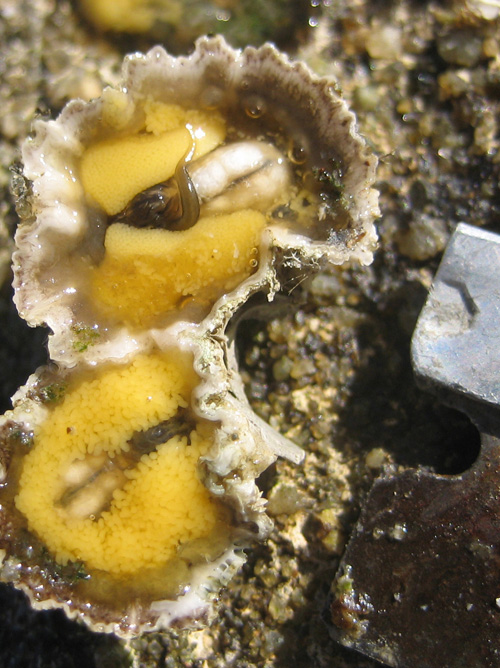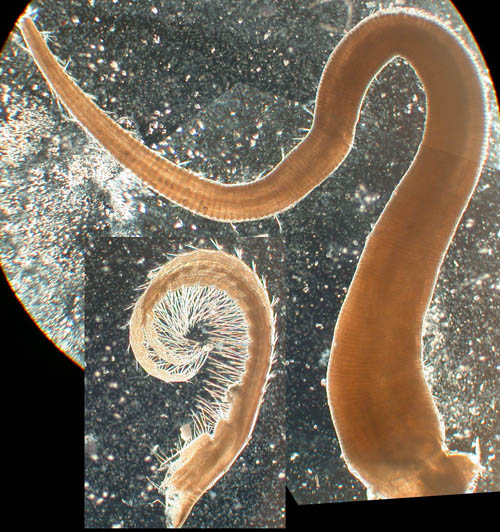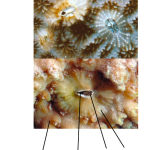
Post by Matt Hoch. Dr. J. Matt Hoch is newly minted PhD from SUNY Stony Brook who is interested in the reproductive ecology and life history evolution of barnacles. We have reported on Matt’s research previously here at DSN.
“Does your mother know what you’re doing?” The question was asked from the back of the room and I responded with what I thought was a truthful answer: “Yes. She is proud of me.” This was one of the only questions that anyone asked me. I had just finished presenting my first talk on my own original work at a national scientific meeting, “A preliminary study of variation in penis characteristics in barnacles.” My mother was at least proud that I was successfully carrying out research in a good PhD program. I don’t actually know if she was proud of my project of choice. I imagine that when telling her co-workers about my project, she might blush or tiptoe around it, but she at least tried to explain it to my grandmother. “Why don’t you try to figure out a way to keep barnacles off my boat?” That’s what my dad asked when I described my dissertation topic to him; “You’ll make us rich!”
It turns out the functional morphology of the barnacle’s…ahem…naughty bit… has important implications for evolutionary theory. Barnacles are familiar as the small rock-like crustaceans growing on almost any hard surface that spends a significant amount of time in salt water. Probably their most famous feature is the glue that they use to anchor themselves. Living this permanently glued lifestyle imparts a few challenges on their ability to mate. Unlike most sessile organisms, which broadcast spawn, barnacles reproduce by copulation. They have to physically couple. Since they can’t get up and walk, the only way to do this is with a penis that is capable of searching for partners and then mating with them. The penis of the barnacle can stretch to about ten times the length of its body during attempts at mating. It’s covered with chemosensory setae, bristles that are capable of detecting chemical signals; basically a series of noses that it uses to smell out receptive mates. Once it locates a receptive partner, it might have to compete with many other barnacles attempting to fertilize the same eggs. Once fertilized those eggs are brooded inside their mother’s shell for several weeks until they are released as larvae.

All of the barnacles involved may act as either a male or female at any given time. They are simultaneous hermaphrodites. An important decision that each barnacle must make is how much effort to put into acting as a male and how much to put into acting as a female. Theory developed by scientific superstars W.D. Hamilton (1967) and Eric Charnov (1980) suggests that competition between barnacles acting as males should drive this decision making process. As more and more barnacles compete to fertilize eggs, they need to produce more sperm to remain competitive. They essentially try to produce enough sperm to overflow the functional female’s mantle cavity and displace the sperm of their competitors. Large quantities of sperm can be deposited in these competitions. So much so that functionally female barnacles have been reported as having so much sperm stuck to their cirri that they are unable to feed.
My work, on variation in penis characteristics, aims to determine how competition between barnacles acting as males changes in different physical environments. For example, in wavy sites, barnacles are unable to reach mates as far away as barnacles in calm bays. When they try, their penises probably get knocked around like crazy. They deal with this by growing thicker penises, which may be more resistant to interference by waves, but lose the ability to stretch as far as the thinner penises grown by barnacles in calm water (Hoch 2008, 2009). Since none of the barnacles in wavy sites can stretch as far, each barnacle acting as a male will have fewer others able to compete with it. They are freed from intense competition, and following Eric Charnov’s predictions, should have larger clutches of eggs.
I recently explained this to my parents. They seemed to understand it, but my dad asked the follow up question that I should have expected. “Can’t you figure out how to manufacture their glue? We could get rich off of that.”
Further Reading
Charnov, E. 1980. Sex Allocation and local mate competition in barnacles. Marine Biology Letters 1:269-272.
Hamilton, W. D. 1967. Extraordinary sex ratios. Science 156:477-488.
Hoch, J. 2008. Variation in penis morphology and mating ability in the barnacle, Semibalanus balanoides. Journal of Experimental Marine Biology and Ecology 359:126-130.
Hoch, J. 2009. Adaptive plasticity of the penis in a simultaneous hermaphrodite. Evolution in press.






Great post! Are there any variations in characteristics of the functionally female barnacles in different physical environments?
Really enjoyed your presentation at Benthics 2008 (most attended session besides the keynotes I’d wager)
One question though. I can see the advantage of a highly plastic penis size in the species, but I wouldn’t think that wave and current conditions change radically at a site after a barnacle settles out. So the first season the barnacle has as adult the ah, die could be cast as it were. What is the energetic cost difference of maintaining one penis, molded to the environmental conditions, versus regrowing the penis every year and then maintaining it for the season?
Oh, just tell your folks your research hopes to lead to a truly functional, if temporary, all natural penis enlargement treatment. If it really came to pass Pfizer would pay you a ROYAL MINT.
Awesome post. Thanks so much, Dr. Hoch. I kept a half dozen enormous Cornula sp. barnacles from a humpback whale carcass off Beaufort, NC, and can attest to their promiscuousness. Has there been much research on these “pelagic” forms?
Fascinating.
Just thought you might be interested to know that I found this article via a newsgroup featuring story links of interest to transgender and intersex activists…many of whom fight a daily battle to convince their detractors that they are simply incorrect in thinking that God’s plan for all of creation is strict sexual dimorphism and heterosexual reproduction, and that anything else is an abomination.
Of course people who believe that, many of whom consider themselves crusaders in a “culture war” of biblical proportions, read those kinds of sites too for reconnaissance purposes…so don’t be surprised if you find yourself accused of helping to “confuse” the little children and indoctrinate them with “the homosexual agenda” by reporting on “mentally disturbed” barnacles who think they are something other than strictly male or female, who engage in “perverted” sex practices.
Sadly, I’m only half joking.
This is a fine article, with great pictures; matt does very nice work. Anyone wanting more general information on some of the issues raised here should read a just published review article : Lukas Scharer 2009.’tests of sex allocation theory in simultaneous hermaphroditic animals’ Evolution 63,1377-1405. Its available free as a pfd on Scharer’s University of Basil web page.
My new year will be better being aware of that!
I’ll look at barnacles with a little more respect from now on!